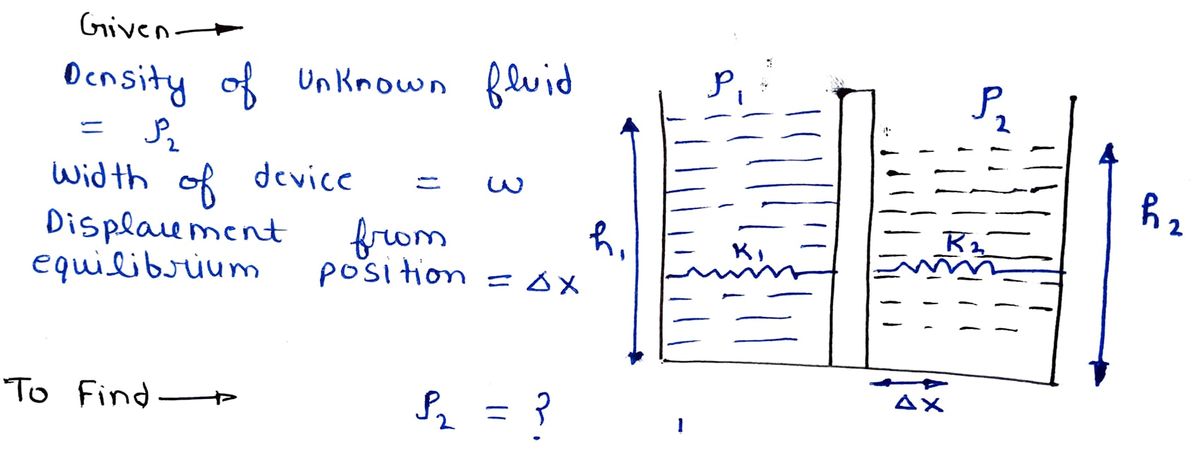2. The apparatus shown below is designed to measure the density of an unknown fluid (p2). The two sides of the levice are separated by a movable, frictionless partition. The partition is attached to the immobile sidewalls of the levice via springs (different spring constants) on either side. Before pouring fluid into the device, both springs are instretched. The device has a rectangular cross-section and extends a width w into the page. Derive an expression or the unknown density p2 = f(p1, h1, h2, k₁, k2, Ax, g), where Ar is the displacement of the partition relative to ts equilibrium location before the fluids are poured into the apparatus. m₂ P1 ww k₁ | P2 ww k₂ Ax h₂
2. The apparatus shown below is designed to measure the density of an unknown fluid (p2). The two sides of the levice are separated by a movable, frictionless partition. The partition is attached to the immobile sidewalls of the levice via springs (different spring constants) on either side. Before pouring fluid into the device, both springs are instretched. The device has a rectangular cross-section and extends a width w into the page. Derive an expression or the unknown density p2 = f(p1, h1, h2, k₁, k2, Ax, g), where Ar is the displacement of the partition relative to ts equilibrium location before the fluids are poured into the apparatus. m₂ P1 ww k₁ | P2 ww k₂ Ax h₂
Elements Of Electromagnetics
7th Edition
ISBN:9780190698614
Author:Sadiku, Matthew N. O.
Publisher:Sadiku, Matthew N. O.
ChapterMA: Math Assessment
Section: Chapter Questions
Problem 1.1MA
Related questions
Topic Video
Question

Transcribed Image Text:2. The apparatus shown below is designed to measure the density of an unknown fluid (p2₂). The two sides of the
device are separated by a movable, frictionless partition. The partition is attached to the immobile sidewalls of the
device via springs (different spring constants) on either side. Before pouring fluid into the device, both springs are
unstretched. The device has a rectangular cross-section and extends a width w into the page. Derive an expression
for the unknown density p2 = f(p1, h₁, h₂, k₁, k2, Ax, g), where Ar is the displacement of the partition relative to
its equilibrium location before the fluids are poured into the apparatus.
h₁
P1
k₁
5
P2
ли
Ax
k₂
h₂
Expert Solution
Step 1

Trending now
This is a popular solution!
Step by step
Solved in 2 steps with 2 images

Knowledge Booster
Learn more about
Need a deep-dive on the concept behind this application? Look no further. Learn more about this topic, mechanical-engineering and related others by exploring similar questions and additional content below.Recommended textbooks for you

Elements Of Electromagnetics
Mechanical Engineering
ISBN:
9780190698614
Author:
Sadiku, Matthew N. O.
Publisher:
Oxford University Press

Mechanics of Materials (10th Edition)
Mechanical Engineering
ISBN:
9780134319650
Author:
Russell C. Hibbeler
Publisher:
PEARSON

Thermodynamics: An Engineering Approach
Mechanical Engineering
ISBN:
9781259822674
Author:
Yunus A. Cengel Dr., Michael A. Boles
Publisher:
McGraw-Hill Education

Elements Of Electromagnetics
Mechanical Engineering
ISBN:
9780190698614
Author:
Sadiku, Matthew N. O.
Publisher:
Oxford University Press

Mechanics of Materials (10th Edition)
Mechanical Engineering
ISBN:
9780134319650
Author:
Russell C. Hibbeler
Publisher:
PEARSON

Thermodynamics: An Engineering Approach
Mechanical Engineering
ISBN:
9781259822674
Author:
Yunus A. Cengel Dr., Michael A. Boles
Publisher:
McGraw-Hill Education

Control Systems Engineering
Mechanical Engineering
ISBN:
9781118170519
Author:
Norman S. Nise
Publisher:
WILEY

Mechanics of Materials (MindTap Course List)
Mechanical Engineering
ISBN:
9781337093347
Author:
Barry J. Goodno, James M. Gere
Publisher:
Cengage Learning

Engineering Mechanics: Statics
Mechanical Engineering
ISBN:
9781118807330
Author:
James L. Meriam, L. G. Kraige, J. N. Bolton
Publisher:
WILEY